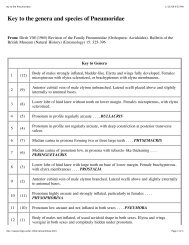full text - Caspar Bgsu - Bowling Green State University
full text - Caspar Bgsu - Bowling Green State University
full text - Caspar Bgsu - Bowling Green State University
Create successful ePaper yourself
Turn your PDF publications into a flip-book with our unique Google optimized e-Paper software.
2. Evolutionary Aspects of Aggression: The Importance of Sexual Selection 11<br />
investments in the mammal zygotes differ only marginally in relation to the body<br />
mass of most mammals, the cost to mammal females greatly exceeds that to males<br />
due to effects of pregnancy and lactation. This energy investment inequality has<br />
existed since the origin of the class Mammalia, 125 million years ago.<br />
There are some exceptions to the general mammalian pattern, however.<br />
For instance, some mammal babies are so expensive to bring up to maturation that<br />
both sexes have to partake in the upbringing for it to be possible. In these species,<br />
where males and females work together to guard and rear the young, intrasexual<br />
competition occurs just prior to pair formation. In these species, the two sexes are<br />
usually morphologically alike. In other mammal species, however, competition<br />
between males over mating opportunities is fierce. In some species this affects the<br />
entire social life of the species, in that males physically exclude other males from<br />
the group. The result is a social system akin to a harem structure, with immature<br />
males roaming outside the social gathering or forming bachelor groups.<br />
The importance of sexual selection in understanding aggression in<br />
mammals is most clearly illustrated by the presence and absence of weaponry.<br />
For example, male ungulates are commonly equipped with horns while females<br />
are not. Horns would be a good weapon to fend off predators, especially when you<br />
need to defend your young, or to fight off conspecific competitors. But most<br />
young are cared for by single mothers; the fathers—who have the weapons—are<br />
absent. Ungulate horns are commonly ready just in time for rutting season and<br />
are then shed (e.g., deer). Instead of predator defense, male ungulates mainly use<br />
their horns to fight each other (Caro et al., 2003; Stankowich and Caro, 2009).<br />
A similar case can be made for the large, sharp canines of primates (Thorén et al.,<br />
2006), and large body size in male mammals in general (Lindenfors et al., 2007a).<br />
Such sex-skewed distribution of size and weaponry, in combination with observations<br />
of fierce aggression, is what enables us to assert that most serious conflict and<br />
aggression in mammals is over mating opportunities.<br />
Sexual selection acting primarily on one sex may have indirect but<br />
pronounced consequences for the relationship between the sexes. Thus, direct<br />
conflicts between males sometimes result in conflicts of interest between males<br />
and females. Early thoughts on this issue (Parker, 1979, Trivers, 1972; Williams,<br />
1966) have received much empirical support (Arnqvist and Rowe, 2005), and it<br />
now almost seems the norm rather than an exception that there exists such a<br />
conflict and that this becomes more severe under strong intrasexual competition.<br />
This can lead to the interesting phenomena of sexually antagonistic coevolution<br />
where males and females become involved in an arms race, as traits in one sex<br />
entice the evolution of resistance in the other (Holland and Rice, 1998;<br />
Gavrilets et al., 2001; and others). On the other hand, intrasexual competition<br />
can lead to one sex dominating the other. With regard to aggression and physical<br />
prowess, the common situation in mammals, including primates (Hrdy, 1981), is<br />
that males are physically dominant over females.



